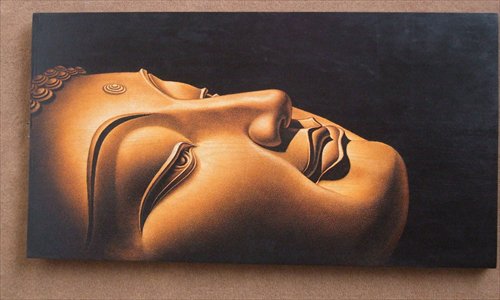
Dizangwang Bodhisattva(Photo/Global Times)
As a stronghold of the historic Silk Road and a treasure house of Buddhist culture, Dunhuang in China's northwestern Gansu Province is one of the favorite destinations for tourists at home and abroad. Though amazed by the grandeur and beauty of the art painted in its caves, for years tourists could do little or nothing to bring those precious memories home with them, confined by restrictions on photography.
Now things are different. Visitors going there will find that a local art, woodcutting, is enjoying great popularity in the market.
"Woodcutting is a new art that has only been developed for a decade in Dunhuang," said Shen Hongjie who is one of the first artists engaging in this art in the region.
A transplant from Yunnan
The woodcuts of Dunhuang get their origin from Yunnan, a province in China's southwestern region that is plentiful in the types of wood required for woodcutting, such as the Cuckoo tree.
About 10 years ago, artisans from Yunnan transported their traditional techniques for woodcutting, which usually featured local representative images like peacock and Dongba script (an ancient form of hieroglyphic).
In 2004, when Shen first came to Dunhuang from Yunnan, he was astonished by the breathtaking murals and statues within the Mogao Grottoes. But meanwhile he felt it was a pity that people were unable to bring those images out of the Grottoes. "I wanted to present the beautiful Apsaras using a different form of art that people could keep for themselves, so I stayed," Shen told the Global Times.
Now after 10 years of development, woodcuts are becoming increasingly popular for their displays of Dunhuang culture. "There are no other places in the country that have this art besides these two places," said Shen, "and the demand for woodcuts here now is even higher that in Yunnan, with sales in Dunhuang several times that of Yunnan," said Shen.
New art depicts local culture
As a new art, woodcutting requires a combination of artistic skills including painting, engraving and laying of colors. Since taking root in Dunhuang in 2004, its 10 years of development have witnessed a series of changes from the price and buyers, to the artistic skills and varieties of this art.
"Ten years ago, only several people were doing this out of interest or to make a living. Now it is a new way to display local culture, and more than 100 people are doing it," said Wang Jialin, vice chairman of Dunhuang Art and Sculpture Association.
Another positive development is that the images on the woodcuts have been expanded from the earlier Dunhuang cultural symbols like Apsaras and Bodhisattva, to wider varieties including local representative sights including Yueya Fountain and Mingsha Mountain, and animals like camels and tigers. And their prices range from dozens to hundreds of thousands of yuan.
"The most favored pieces are those featuring Apsaras and local scenery priced between thousands of yuan to 10,000 yuan ($1,615)," said Shen.
Ten years ago when Shen first began working in Dunhuang, he could make several simple pieces a day and the prices were low, but now one woodcut may take him several days and sometimes even several months to finish. These pieces can command prices in the hundreds of thousands of yuan.
Shen's transition was motivated by the rapid development of this sector and the uneven product quality that resulted. In the beginning there were only three to five practitioners. But when that number burgeoned to its current total of more than 100, it became clear that not all of the craftsmen possessed the same exquisite skills.
